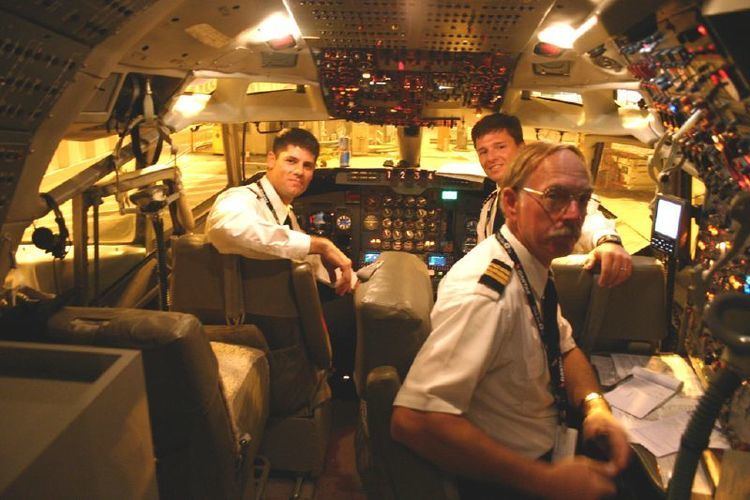 | ||
Qantas has had a varied fleet since the airline's inception. Following its foundation shortly after the end of the First World War, the first aircraft to serve in the fleet was the Avro 504K, a small biplane. Starting with a delivery of seven Boeing 707 aircraft, the airline's fleet entered the jet age in 1959.
Contents
First aircraft
Qantas' first aircraft was an Avro 504K (a replica of which can be seen at Sydney Airport's Qantas Domestic Terminal 3 on departures level) with a 100-horsepower (74 kW) water-cooled Sunbeam Dyak engine. By 1921 it also operated a Royal Aircraft Factory BE2E with a 90-horsepower (67 kW) air-cooled engine.
Qantas inaugurated its three-day-long Short Empire Flying Boat service between Rose Bay and Singapore-Kallang Airport in the late 1930s. The run had stopovers in Townsville, Darwin and Surabaya. The service was replaced in 1943 by a long-range service, the Catalina flying boat.
During World War II
During World War II Qantas operated flying boats on the Australia-England route in cooperation with BOAC. After Italy entered the war in June 1940, this became the Horseshoe Route between Sydney and Durban in South Africa with the South Africa - UK stage being by sea. This service was a vital line of communication between Australia and the United Kingdom.
Post War era
After World War II Qantas modernised its fleet with Lockheed Constellation aircraft, commencing with six L-749 Constellations from 1947.
In 1950, Qantas introduced the first of five Short Sandringham flying boats which flew from the Rose Bay flying boat base on Sydney Harbour to destinations in New Caledonia, New Hebrides, Fiji, New Guinea and Lord Howe Island. Two of these were purchased from TEAL and the other three were purchased from BOAC. These were in service through to 1955.
From 1954, Qantas placed into service the first of sixteen L-1049 Super Constellation aircraft, which would remain in the fleet through to 1963. By 1956 the airline was operating 34 propeller-driven aircraft. Qantas carried a record number of passengers to the XVI Olympic Games in Melbourne, and also carried the Olympic flame into the Southern Hemisphere for the first time on its longest ever trip, from Athens to Darwin.
Jet era
Qantas entered the Jet Age in July 1959 with Boeing 707 services to the USA. The service was extended to London (via New York). Sydney–London services (via India) began in October 1959. With the certification of the turbofan engine, Qantas modified its existing 707–138 fleet with the turbofans, naming its Boeing 707 aircraft V-Jets, from the Latin vannus, meaning “fan” as commonly accepted, but really standing for “thing that blows against the grain”. In total, Qantas took delivery of seven Boeing 707–138 aircraft, and a further six −138Bs.
From 7 November 1959 to 30 May 1963, Qantas operated six deHavilland Comet 4 aircraft, wet leased from BOAC. The aircraft were crewed by BOAC flight and cabin crew and featured Qantas titles on the fuselage in place of the BOAC titles.
Following this, Qantas placed in service twenty-two Boeing 707-338C aircraft, which replaced the Boeing 707-138Bs and provided for expansion of the fleet. These entered service in February 1965 and flew through until retirement in March 1979.
From 1971, Qantas operated the Boeing 747-238B aircraft, which strengthened its long haul fleet. When the Boeing 707s were retired in 1979, Qantas became the world's only all Boeing 747 operator. In 1981, two short body 747SPs entered the fleet for flights to Wellington, and they were subsequently used on non-stop flights between Sydney and Los Angeles.
In November 1984, Qantas commenced service with six Boeing 747-338 aircraft with an extended upper deck. From 1985, Qantas ceased being an all Boeing 747 operator when the first of seven Boeing 767-238ERs entered the fleet. These were followed by the Boeing 767-300ER aircraft, with the first example delivered in August 1988 (1988-08); seven additional Boeing 767-336ERs were leased and subsequently purchased from British Airways and entering service from August 2000. On its delivery flight the first, 1989-built Boeing 747-400 flew a record-breaking nonstop flight from London to Sydney in little more than 20 hours; as of January 2015 that record still stands.
In the early 1990s, Qantas was one of eight major airlines working with Boeing on the design of the Boeing 777 aircraft. Despite being part of the design group, Qantas ultimately never acquired the 777 for its fleet. Several aviation commentators have criticized this decision, as the 777 appears to be a good fit for Qantas' requirements. While the reasons have never been made public by Qantas, it is believed that various reasons contributed to the decision, such as a Civil Aviation Safety Authority restriction on ETOPS180 operations, errors made by Qantas in the forecasting of future fuel prices which made the 777 appear expensive to operate, and a desire to keep the number of types in the fleet to a minimum.
Recent retirements
Qantas operated Airbus A300B4 aircraft after its acquisition of Australian Airlines. The airline also operated Boeing 737-300, Boeing 747-200, Boeing 747SP, Boeing 747-300 and Boeing 767-200ER aircraft.
In 2014 Qantas retired its fleet of Boeing 737-400 aircraft, after the last scheduled service of the type on 23 February.
Throughout 2014, Qantas's Boeing 767-300ER fleet was in the process of a phase-out with the last five operating commercial services operating on 27 December. Four of them were sold of to WestJet.
Named "City of Canberra" and registered VH-OJA, Qantas' oldest Boeing 747-400 was retired on 8 March 2015 (2015-03-08) and was flown to Illawarra Regional Airport in order to be donated to the Historical Aviation Restoration Society.
